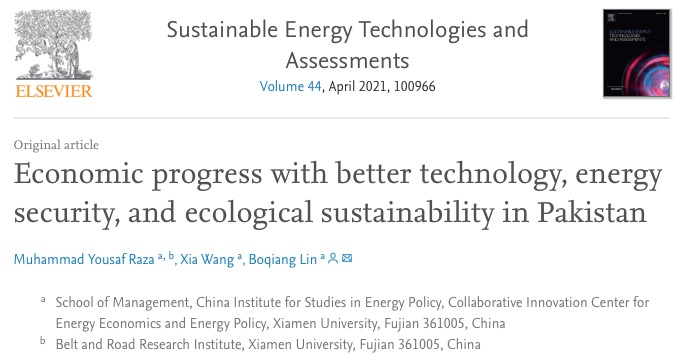
题目:巴基斯坦技术进步、能源安全、生态可持续的经济发展(Economic progress with better technology, energy security, and ecological sustainability in Pakistan)
作者:Muhammad Yousaf Raza,王霞,林伯强*
期刊:可持续能源技术和评估(Sustainable Energy Technologies and Assessments)
详细:44卷,2021年4月
DOI:https://doi.org/10.1016/j.seta.2020.100966
文献导读:
巴基斯坦是南亚人口第六大的共和国,伴随着经济发展,能源需求快速增加。2018年,巴基斯坦能源供应总量为8630.1万吨石油当量(Mtoe)。石油、天然气、液化天然气(LNG)、液化石油气、煤炭和电力的贡献分别为31.2%、34.6%、8.7%、1.2%、12.7%和11.6%。为满足经济发展、生活水平和工业需求,2018年各类能源进口份额显著增加,如进口的原油增加98.3%、液化天然气增加68.2%,煤炭增加94.9%,能源安全问题突出。然而,巴基斯坦在可再生能源增长方面发展缓慢,与2017年相比,装机容量增加了402兆瓦。由于巨大的能源消费,巴基斯坦1980年至2018年的二氧化碳排放量从27.821Mt增加到195.706Mt。气候变化会影响天气、居民生活和产业收入,自2010年以来已经造成约96亿美元的损失。
本文试图研究1980-2018年期间能源(化石燃料和电力)和非能源(劳动力和资本)投入要素的潜在替代性,分析各投入要素对经济增长的贡献,明确巴基斯坦应采取哪些能源或要素投入,以促进技术进步,推动可再生能源发展,提升能源安全,并减少二氧化碳排放。
Abstract: Energy consumption in different sectors in Pakistan has risen from the last two decades, which has brought immerse ecological risk from carbon dioxide (CO2) emission. This research tried to examine potential substitutability of energy (fossil fuel and electricity) and non-energy (labor and capital) input factors by applying the trans-log production method during 1980–2018. We applied Ridge regression method to test the factors after our data presented multicollinearity. The outcomes show that: (1) all the output elasticities of labor, capital, fossil fuel, and electricity are positive, which shows that all the factors are contributing to economic growth. (2) The substitution of alternative inputs (i.e., capital-electricity, capital-labor, capital-fossil fuel, and labor-fossil fuel) show maximum substitutability among them, and their values are close to unity. Capital and electricity substitution suggests that huge investment in renewable energy, which will remove energy subsidies in supporting capital and labor. (3) The inputs’ fossil fuel-labor and electricity-labor are substitutes with their relative technological progress, while other input factors also presenting proof of convergence. This proposes that redirecting resources into the development of technology to clean energy production like electricity will be an achievement over time with CO2 mitigation. Finally, with the increase in 5% and 10% of investment scenarios in fuel reduction and electricity capital, the technologies would reduce CO2 emissions by 22.05, 19.94, 12.44, and 11.25 Mt during 2018. Based on the investigated method, the policy suggestions concerned with the estimated results are discussed below.
Keywords: trans-log production function; CO2 emissions; elasticity of substitution; technical change; Pakistan
 厦大总机:0592-2180000
|
地址:福建省厦门市思明区思明南路422号
|
邮政编码:361005
厦大总机:0592-2180000
|
地址:福建省厦门市思明区思明南路422号
|
邮政编码:361005